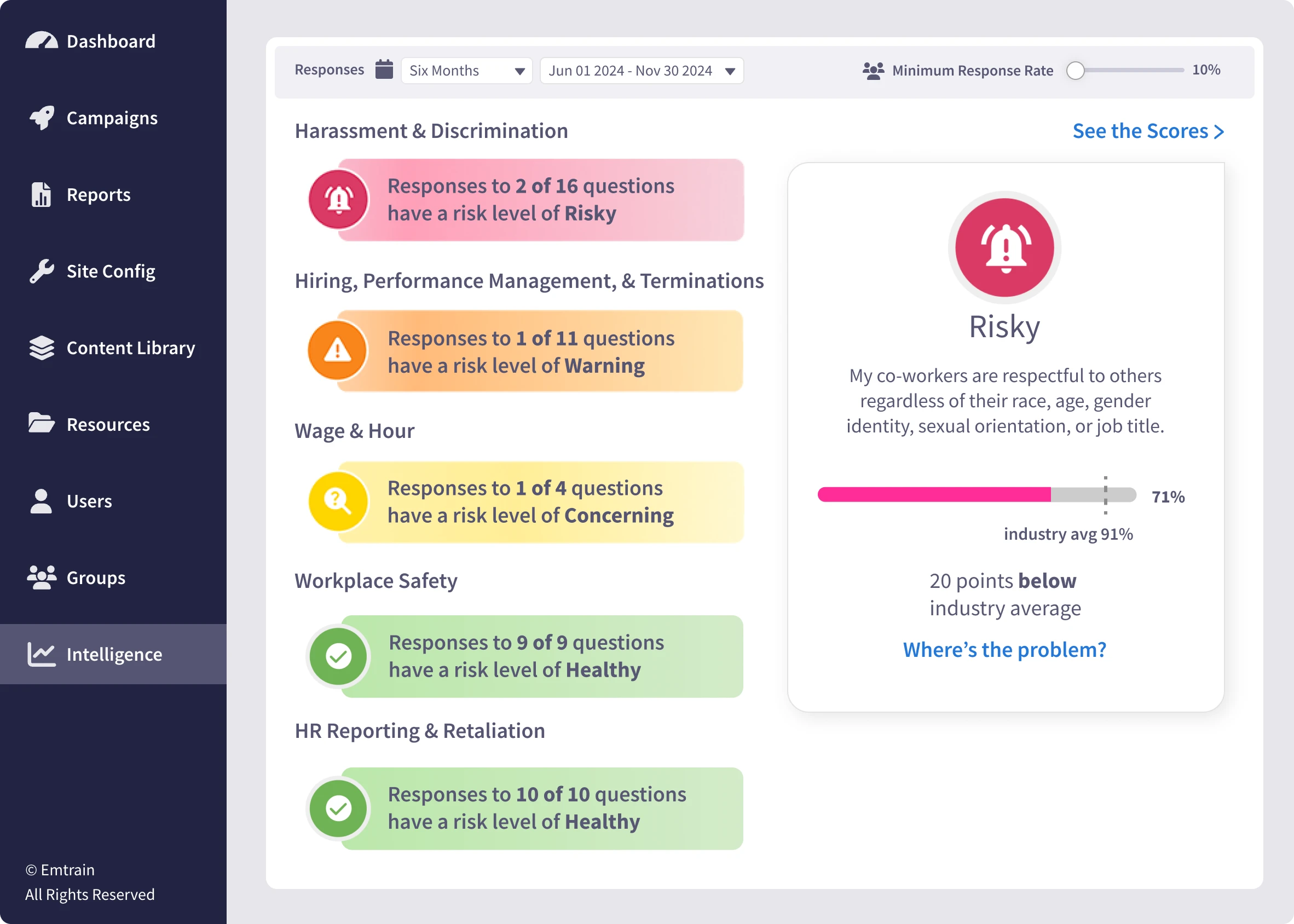Home » Concepts » Discrimination & Harassment » Severe & pervasive
Severe and pervasive conduct refers to workplace harassment or discrimination that is both extreme in nature and frequent in occurrence. This type of behavior significantly disrupts an employee’s ability to perform their job, creating a hostile, intimidating, or abusive work environment. Legally, such actions must meet specific criteria to be actionable under anti-discrimination laws.
Emtrain’s harassment training course is engaging, interactive, and designed to spot and reduce EEO risk.

Workplace harassment laws in the U.S. emerged as part of the Civil Rights Movement of the 1960s, primarily driven by Title VII of the Civil Rights Act of 1964. This act aimed to prohibit discrimination based on race, color, religion, sex, or national origin. Over the years, landmark cases and evolving societal norms have brought attention to how severe and pervasive conduct violates workers’ rights and undermines workplace equality.
The legal standard of “severe and pervasive” in workplace harassment cases has evolved through significant court rulings. In Harris v. Forklift Systems, Inc. (1993), the U.S. Supreme Court established that conduct must be both objectively and subjectively offensive to be actionable, meaning it must create an environment that a reasonable person would find hostile or abusive, and the victim must perceive it as such. This standard aims to balance protecting employees from harassment while allowing for the normal ebbs and flows of workplace interactions.
Over time, this standard has been scrutinized for potentially setting too high a bar for plaintiffs, as isolated incidents or less overt behaviors might not meet the “severe and pervasive” threshold yet still contribute to a hostile work environment. Consequently, there have been calls for legal reforms to lower this threshold, enabling more victims to seek redress and fostering more inclusive workplaces.
Workplace harassment remains a significant issue. In fiscal year 2023, the U.S. Equal Employment Opportunity Commission (EEOC) received 81,055 new discrimination charges, marking a 10% increase from the previous year. (Source: Equal Employment Opportunity Commission)
Notably, retaliation was the most frequently filed charge, cited in nearly 60% of cases, underscoring the persistent challenge of addressing and mitigating severe and pervasive behaviors in the workplace. (Source: Easi Consultants)
The effects of severe and pervasive harassment on employees are profound. A study by the EEOC found that 90% of individuals who experience harassment never take formal action, such as filing a complaint, often due to fear of retaliation or disbelief in the effectiveness of reporting mechanisms. (Source: Equal Employment Opportunity Commission)
This lack of reporting allows toxic behaviors to persist, leading to decreased employee morale, increased turnover, and potential legal liabilities for organizations.
Severe and pervasive behaviors can manifest in various ways, significantly impacting workplace dynamics:
These scenarios illustrate how unchecked severe and pervasive behaviors can erode workplace culture and employee well-being.
To effectively address severe and pervasive behaviors, organizations should implement comprehensive strategies:
By fostering an environment of zero tolerance toward harassment and encouraging open communication, organizations can mitigate the occurrence of severe and pervasive behaviors.
If you experience or witness severe and pervasive behavior in the workplace:
Taking these steps can help address the behavior and contribute to a safer work environment.
Implementing these practices fosters a culture of respect and accountability.
Microlesson: Blindspots and Inappropriate Behavior
This microlesson illustrates how coworkers can provide instant, non-confrontational feedback when they observe inappropriate behavior, promoting a respectful workplace.
Course: Preventing Workplace Harassment Training — US
This course educates employees on the legal definitions of harassment, identifying severe and pervasive conduct, and understanding protected characteristics under state and federal laws.
Resource: Preventing Sexual Harassment in the Workplace Training Deck
This resource equips organizations with the tools to create effective harassment prevention programs, including clear definitions, examples, and actionable steps to address issues.
Blog: Workplace Harassment Training: Important Topics to Cover
This blog explores key areas organizations should address in harassment training, such as understanding power dynamics and creating a culture of respect.
Video Preview: Workplace Harassment: Power Dynamics
In a hotel lounge before a major presentation, a male employee’s flirtatious behavior leaves his female colleague uncomfortable, demonstrating how power dynamics can contribute to pervasive workplace harassment.